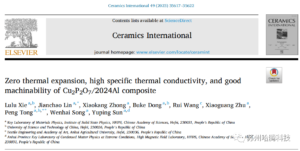
Fast Hot Pressing Sintering Preparing WC-Reinforced HEA
Fast Hot Pressing Sintering ceramic and metal composite to obtain a metal-ceramic composite material that is both strong and wear-resistant.
Home » TECHNICAL INFORMATION » COMPOSITES
FAST (Field-assisted Sintering Technology)/ DCS (Direct Current Sintering) is an advanced powder metallurgy technology that integrates plasma activation, pressurization, heating and sintering of alloy powders. Under the combined action of current and pressure, materials can be synthesized in only one step. With its rapid heating and cooling rates, high sintering efficiency and good connection effect, it has attracted widespread attention and heated discussions among researchers. With the continuous deepening of research, this technology has been widely used in the preparation of various materials, such as metals, ceramics, and composite materials. Including materials that are not easy to sinter, novel carbon-containing materials, most nanocrystalline metal functional gradient materials and materials with complex shapes.

Fast Hot Pressing Sintering ceramic and metal composite to obtain a metal-ceramic composite material that is both strong and wear-resistant.

Using of SPS Spark Plasma Sintering Technology is a new concept for cross-scale, multi-level design of tungsten-copper composites.

SPS Spark Plasma Sintering Furnace records the densification process in real-time of ZrO2–SiO2 Composite Glass Ceramic Materials

Spark Plasma Sintering is an efficient experimental method for Boron Carbide Bulletproof Ceramics. It obtains the samples in a maximum of two hours.

Direct current sintering (DCS) was used to study the various properties of barium titanate-based HEA with different formulations.

Spark plasma sintering technology has a fast heating rate and short holding time, so the product has a small grain size and few pores, and can achieve an unprecedented bending strength of 94.5MPa.

SPS sintering process can obtain a high entropy alloy with uniform distribution of tungsten carbide reinforcement phase.

Field-assisted sintering experiment used in this work was completed on the CNE-FHP-828 field-assisted sintering technology furnace produced by our company.

This article demonstrates the excellent effect of the field-assisted sintering technology from the perspective of isotope analysis, which is good proof of the uniformity of the sintered samples.

The team of Professor Yang Zirun of Yancheng Institute of Technology using field-assisted sintering technology preparation MoAlB material.

Field-assisted sintering technology preparation ZTA ceramics shows that 5% copper-doped ZTA ceramics have a lower friction coefficient.

Compounded with Al2024, a zero-expansion aluminum-based composite material was prepared by field assisted sintering technique.